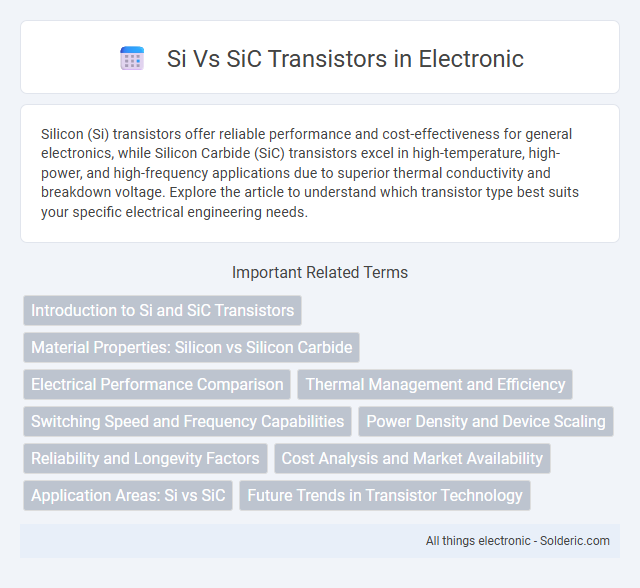Silicon (Si) transistors offer reliable performance and cost-effectiveness for general electronics, while Silicon Carbide (SiC) transistors excel in high-temperature, high-power, and high-frequency applications due to superior thermal conductivity and breakdown voltage. Explore the article to understand which transistor type best suits your specific electrical engineering needs.
Comparison Table
| Feature | Silicon (Si) Transistors | Silicon Carbide (SiC) Transistors |
|---|---|---|
| Material | Silicon (Si) | Silicon Carbide (SiC) |
| Bandgap | 1.1 eV | 3.26 eV |
| Thermal Conductivity | 150 W/m*K | 490 W/m*K |
| Maximum Operating Temperature | ~150degC | > 300degC |
| Switching Speed | Moderate | High |
| Power Efficiency | Lower | Higher |
| Breakdown Voltage | Up to ~600 V | Up to > 1200 V |
| Application | General purpose, low to medium power electronics | High power, high temperature, high frequency applications |
| Cost | Lower | Higher |
Introduction to Si and SiC Transistors
Silicon (Si) transistors have been the industry standard for decades due to their well-established manufacturing processes and moderate cost, offering reliable performance in a wide range of electronic applications. Silicon Carbide (SiC) transistors, made from a wide-bandgap semiconductor, provide superior electrical efficiency, higher breakdown voltage, and better thermal conductivity, making them ideal for high-power and high-temperature environments. SiC devices enable faster switching speeds and lower energy losses, significantly improving performance in power electronics compared to traditional Si transistors.
Material Properties: Silicon vs Silicon Carbide
Silicon Carbide (SiC) transistors offer higher bandgap energy (3.26 eV) compared to silicon's 1.12 eV, enabling superior thermal stability and higher voltage operation up to 3,000 V. SiC devices exhibit greater electron mobility and electric field breakdown strength, enhancing switching speed and power efficiency under high-temperature conditions above 175degC, where silicon transistors typically degrade. These material property advantages make SiC transistors ideal for high-power, high-frequency applications such as electric vehicles and renewable energy systems.
Electrical Performance Comparison
SiC transistors exhibit superior electrical performance compared to traditional Si transistors, featuring higher breakdown voltage and faster switching speeds due to their wide bandgap material properties. SiC devices demonstrate lower on-resistance and reduced power losses, enabling improved efficiency in high-power and high-temperature applications. This results in enhanced thermal stability and reliability, making SiC transistors ideal for demanding environments such as electric vehicles and power electronics.
Thermal Management and Efficiency
Silicon Carbide (SiC) transistors exhibit superior thermal conductivity, reaching around 3.7 W/cm*K compared to Silicon's (Si) 1.5 W/cm*K, enabling more efficient heat dissipation and higher temperature operation. This thermal advantage allows SiC devices to maintain performance under high power densities, reducing cooling system requirements and improving overall efficiency. Consequently, SiC transistors support higher switching frequencies and lower energy losses, making them ideal for power electronics applications demanding robust thermal management and enhanced energy efficiency.
Switching Speed and Frequency Capabilities
SiC transistors exhibit significantly higher switching speeds and frequency capabilities compared to traditional Si transistors due to their wide bandgap properties and lower intrinsic carrier concentration. This allows SiC devices to operate efficiently at higher frequencies, making them ideal for applications such as high-frequency power conversion and RF systems. You can achieve reduced switching losses and improved thermal performance with SiC transistors, enhancing overall system efficiency.
Power Density and Device Scaling
SiC transistors exhibit significantly higher power density compared to Si transistors due to SiC's wider bandgap and superior thermal conductivity, allowing for greater current handling in smaller device footprints. Device scaling in SiC technology benefits from its ability to operate at higher voltages and temperatures without performance degradation, enabling more compact and efficient power electronics. Your designs can achieve improved efficiency and reduced system size by leveraging SiC transistors over traditional Si devices in high-power applications.
Reliability and Longevity Factors
SiC transistors exhibit superior reliability and longevity compared to traditional Si transistors due to their wide bandgap properties, which enable higher thermal conductivity and resistance to thermal stress. These characteristics reduce degradation under high-temperature and high-voltage conditions, extending device lifespan in demanding applications. Your choice of SiC transistors ensures enhanced performance stability and reduced failure rates in harsh environments.
Cost Analysis and Market Availability
Silicon (Si) transistors remain more cost-effective due to established manufacturing processes and widespread market availability, making them the preferred choice for low to medium power applications. Silicon Carbide (SiC) transistors, while offering superior performance in high-temperature and high-voltage environments, typically come with a higher price point due to complex fabrication and limited production scale. Your decision should balance budget constraints with performance needs, considering SiC's growing market presence as demand for efficient power electronics increases.
Application Areas: Si vs SiC
Si transistors remain widely used in consumer electronics, power supplies, and low-frequency applications due to their cost-effectiveness and mature manufacturing processes. SiC transistors excel in high-power, high-temperature environments such as electric vehicles, renewable energy systems, and industrial motor drives because of their superior thermal conductivity and higher breakdown electric field. The choice between Si and SiC transistors depends on factors like switching frequency, efficiency requirements, and operating conditions, with SiC favored for demanding power electronics applications.
Future Trends in Transistor Technology
Silicon carbide (SiC) transistors demonstrate superior performance in high-temperature and high-voltage applications compared to traditional silicon (Si) transistors, driving future trends toward power electronics with increased efficiency and reliability. Emerging wide-bandgap semiconductor technologies like SiC enable higher switching frequencies and reduced energy loss, critical for electric vehicles, renewable energy systems, and industrial automation. Research and development focus on improving SiC fabrication processes and cost-effectiveness to accelerate widespread adoption in next-generation transistor technology.
Si vs SiC transistors Infographic

 solderic.com
solderic.com